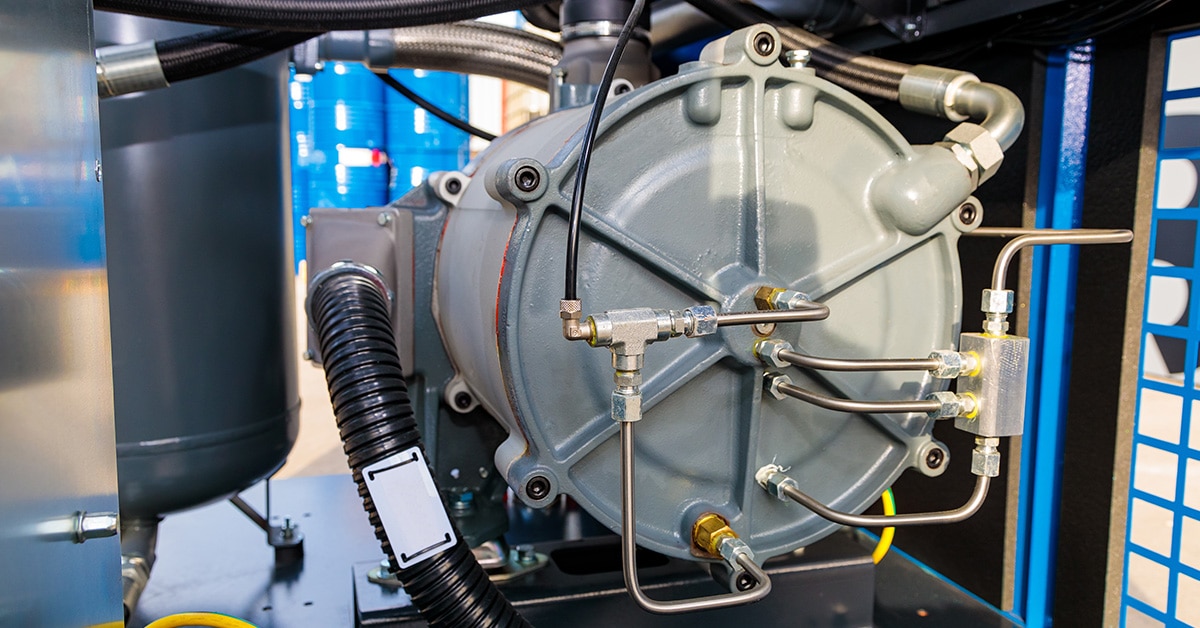If your manufacturing facility relies on compressed air to power tools, equipment or processes, it’s vital to maintain these systems in optimal working condition. Any leaks, worn-out parts or improperly calibrated components can have a significant domino effect throughout your operations. Although they may not be immediately apparent, you will eventually notice the effects through increased energy consumption, overheating or even unexpected breakdowns. This is why you need to take a comprehensive, systematic approach to your industrial compressor maintenance. Creating a checklist, completing regular inspections and leaning into predictive maintenance and machine health monitoring can help you avoid many of the biggest problems you may experience. Continue reading to discover all the essential maintenance practices you should be following for your compressed air systems, if you aren’t doing so already.
Common air compressor issues and warning signs
If you haven’t paid enough attention to your compressors’ maintenance needs, it can lead to a host of issues that can compound over time. If unaddressed for too long, these can lead to significant drops in productivity and efficiency. Here are some of the most common indicators that your maintenance of air compressors is being neglected or mishandled:
- Overheating: If compressors are running at higher-than-normal temperatures, this could be a sign of clogged filters, low oil levels or poor ventilation.
- Unstable pressure and airflow: This symptom may be caused by leaking hoses or fittings, worn-out seals or malfunctioning valves.
- Excessive moisture or condensation: A buildup of moisture on the surface of your equipment might be a warning sign that your dryers or traps are not functioning as they should.
- Unusual noises or vibrations: If your air compressor equipment seems to be rattling or vibrating, you should check for any loose connections, failing bearings or improper mountings.
Industrial air compressor maintenance checklist
Although issues with your air compressors can cause operational disruptions, the silver lining is that keeping them in optimal condition doesn’t require a substantial time or resource investment. With the right air compressor maintenance schedule, you can avoid or prevent many of the most common concerns with your compressors. To help you get started, here’s a sample checklist of important maintenance tasks organized by their recommended scheduling frequency:
Daily/weekly tasks
- Inspect oil levels for compressors that require lubrication
- Drain condensate from tanks or separators
- Check the cooling system, including fans and vents
- Scan for any unusual sounds or vibrations coming from the equipment
Monthly/bi-monthly tasks
- Change or clean intake filters to remove debris
- Inspect drive belts or couplings for signs of tension or wear
- Tighten nuts and bolts for key components
- Run diagnostics checks for pressure, flow and temperature
Quarterly/seasonal tasks
- Replace oil and oil filters in lubricated units per OEM guidelines
- Clean or replace air and oil separators
- Evaluate performance data for signs of higher energy consumption or pressure drops
- Integrate sensor data into predictive maintenance dashboards
Annual/off-season tasks
- Overhaul major components as recommended by OEM, including pumps and motors
- Check the control system or PLC for software updates
- Maintain a thorough maintenance log and cross-reference it with predictive analytics for next-level improvements
Air compressor lubrication and filtration
Proper lubrication and effective filtration are two of the most crucial components for maintaining the functionality of an air compressor system. Regularly lubricate any moving parts to prevent premature wear and ensure optimal performance and longevity. Maintaining clean and functional filters, separators and dryers is necessary to ensuring consistent air quality and preventing malfunctions caused by clogs or excessive moisture. Here’s a quick breakdown of what’s required for each:
Oil and lubrication
- Analysis and sampling: Establishing a routine for sampling oil and analyzing it can help you detect metal wear, contamination or oxidation throughout your systems.
- Oil changes: Your schedule for changing oil will depend on how heavily your systems are used, the average operating temperature and environmental conditions such as excessive dust or humidity in the air.
- Reducing friction and heat: With the proper lubrication levels, you can extend bearing lifespans, prevent scoring on cylinder walls and maintain consistent pressure.
Filtration and air quality
- Air intake filters: Clogged filters cause the compressor to work harder, resulting in higher energy consumption and strain on moving parts.
- Oil and air separators: With clean separation, minimal oil will be carried over in air compression lines and certain issues can be prevented.
- Dryers and desiccants: These help ensure lines remain free from condensate that can build up and cause problems.
- Contamination monitoring: With machine sensors and lab testing, you can keep an eye out for signs of excessive oil in output air or higher moisture levels.
Work with leaders in industrial compressor maintenance
Staying on top of your air compressor maintenance can lead to more uptime, consistent air pressure, reduced energy consumption and extended equipment lifespans. Adhering to the basic checklist provided above will help you guarantee your systems perform optimally when you need them the most. For more guidance on how to optimize your facility’s industrial air compressor maintenance, get in touch with the experts at ATS. Our team can provide specialized maintenance as well as support your preventive maintenance efforts and optimize your systems. To learn more about what we can do for you, reach out and speak with one of our representatives today.






